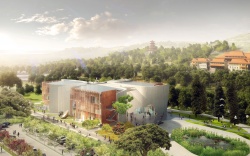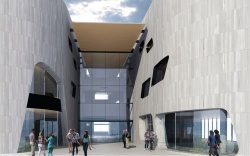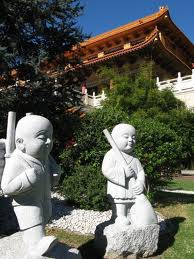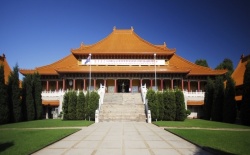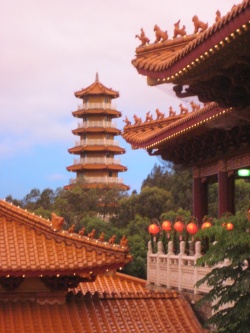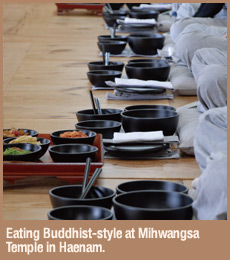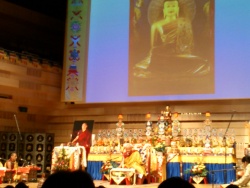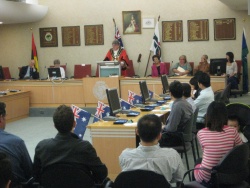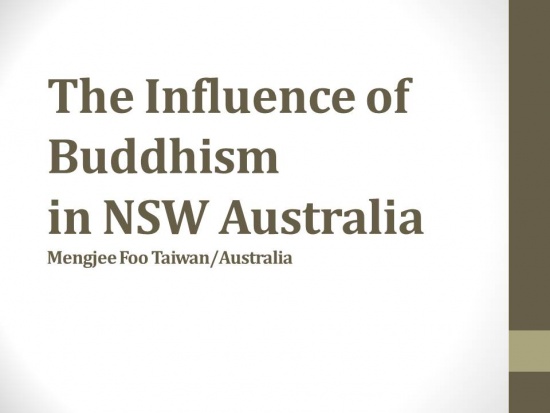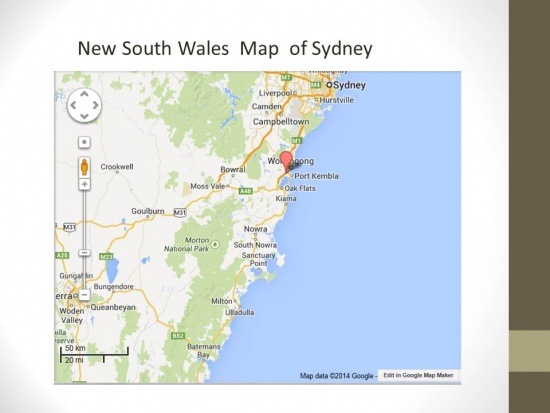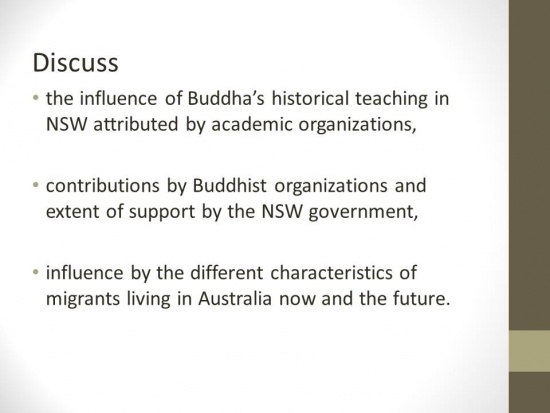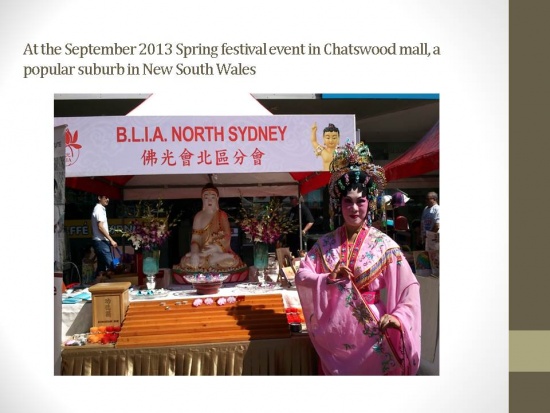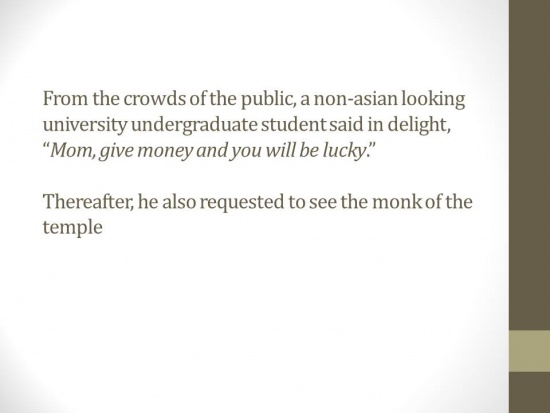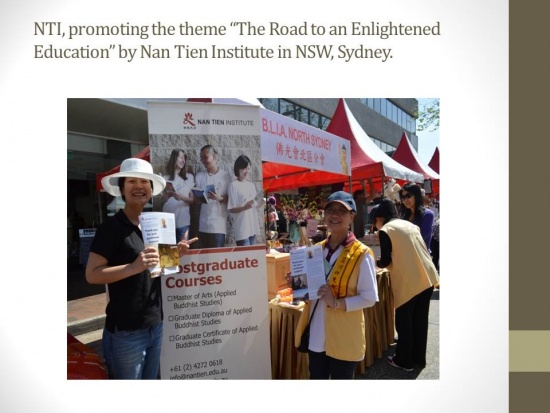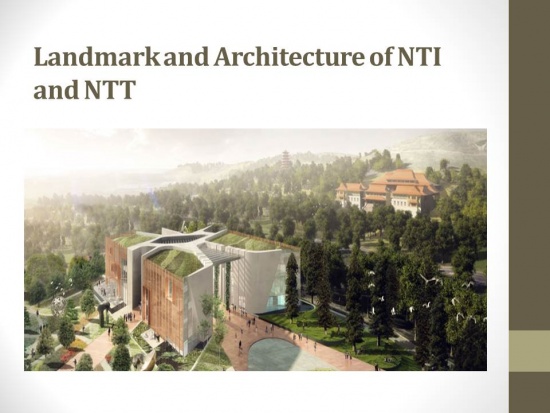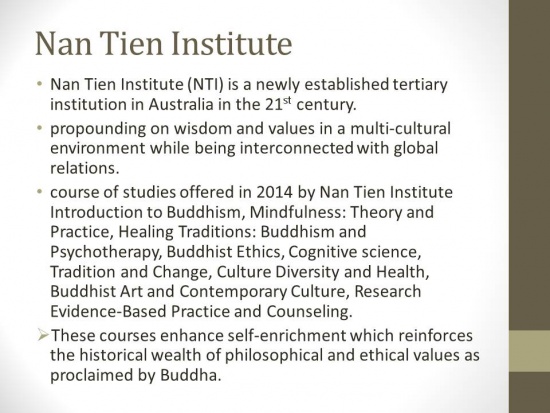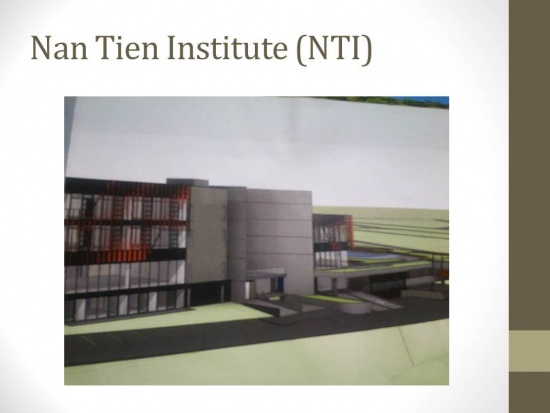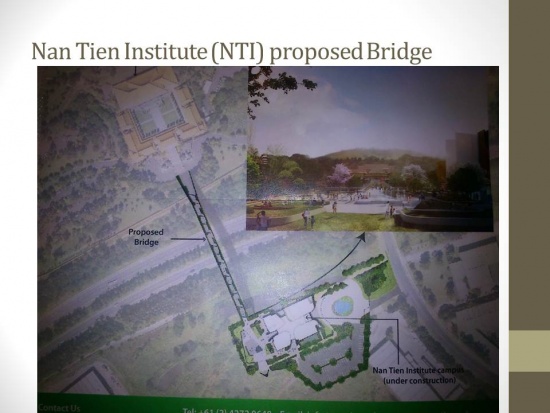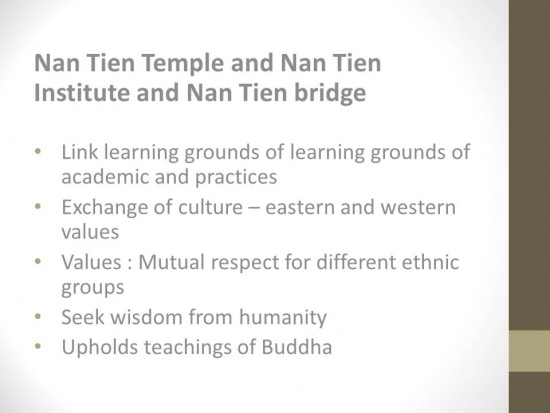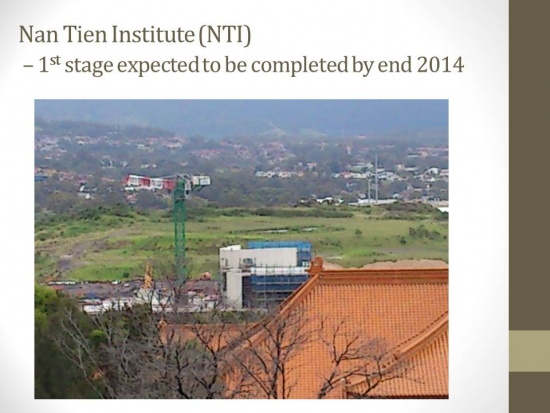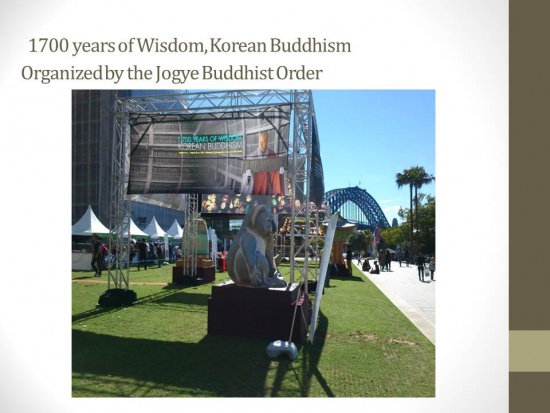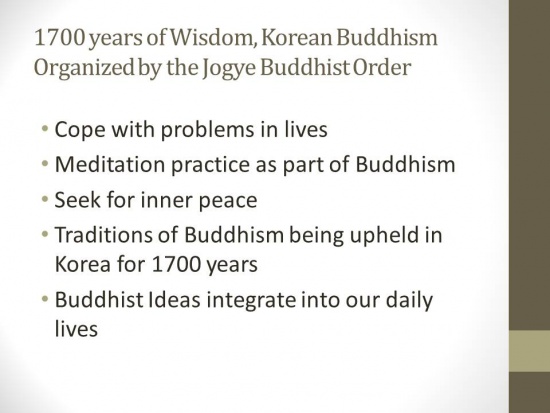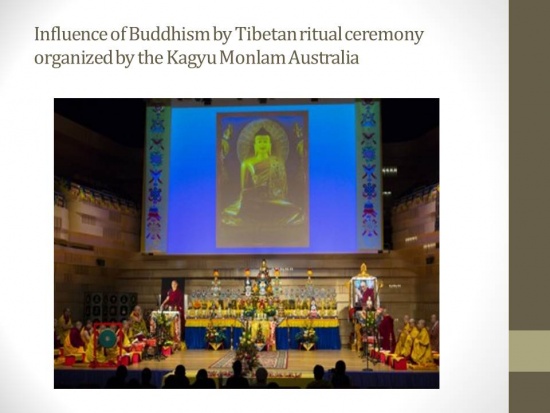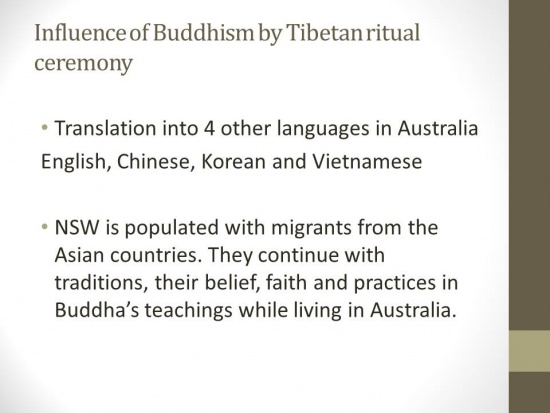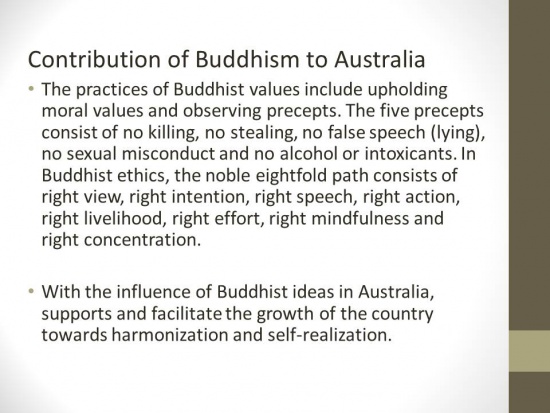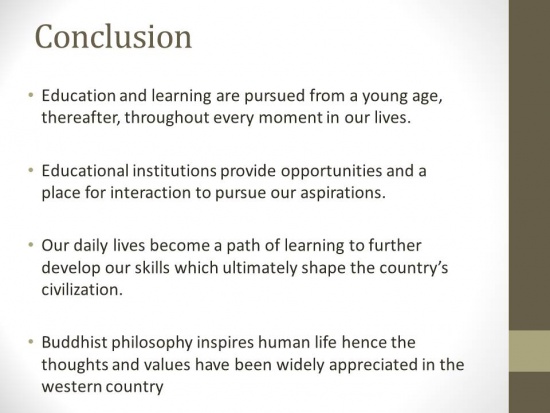The Influence of Buddhism in NSW Australia by Mengjee Foo
The Influence of Buddhism in NSW Australia
By Mengjee Foo
8 Feb 2014
Abstract
Australia has been filled with an influx of migrants from around the world. These migrants bring with them an enriching and diverse culture from countries such as China, Vietnam, Taiwan and Korea.
At the September 2013 Spring festival event in NSW Chatswood mall, there was a display of the statue on the image of Buddha (The Enlightened being) in one of the stalls setup by a Buddhist centre NSW. From the crowds of the public, a non-asian looking university undergraduate student said in delight, “Mom, give money and you will be lucky.” Thereafter, he also requested to see the monk of the temple.
Whilst at the same time, this Buddhist stall was also promoting academic programs with the theme “The Road to an Enlightened Education” by Nan Tien Institute in NSW. This is a newly established institution (since 2011) which conducts courses which are not restricted to Buddhism. Venerable Master Hsing Yun who is the founder of Nan Tien in Australia, originates from Taiwan whereby he promotes the propagation of humanistic Buddhism.
This paper, therefore attempt to discuss the influence of Buddha’s historical teaching in NSW attributed by academic organizations, contributions by Buddhist organizations and extent of support by the NSW government, influence by the different characteristics of migrants living in Australia now and the future.
Key words: Cultural diversity, Buddhist events in New South Wales, Australia
Introduction
Events organized and grounds of establishments by diverse Buddhist organizations contribute and influence the concept of Buddhist ideas in Australia. This paper provides a study on Nan Tien Institute (NTI) which is a newly accredited academic landmark established by a Buddhist organization in this new era. Additionally, this paper also provides reflection based on two events held recently in large public grounds in New South Wales (NSW) Australia. The 1700 Years of Wisdom, Korean Buddhism and a traditional Tibetan Buddhist ritual ceremony.
Time has led the historic existence and words of Buddha to travel far and wide by pilgrims, migrants[1] and traders. The vastness in Buddha’s teaching and its practices as such varies in different time periods and by location. The adapted teachings of each milestone as such, represent the historical thoughts of Buddha. This representation signifies the blend with the conditions, culture and humanitarian needs. With variations in Buddha’s teaching, having travelled from Asia through to the Pacific Ocean, what would be the teaching acquired by down under, Australia now and the future?
Historically, the behavioral patterns of its people and traditional landmarks attribute to Buddha’s teachings. With the different modes of channels, it provides an expression of the heritage, conveying the unique identity of Buddha’s nature. Buddha, proclaimed to have conveyed the teaching expediently. Migrants of different generations who serve as Buddha and bodhisattva skillfully engage the teachings expediently when they reside in different locality. In this regard, this paper relates specifically to NSW Australia.[2]
- Historically, Australia’s extended diversity in culture has led the government to implement policy changes and adopting new programs in the community. Having identified the various ethnic groups and the language skills requirement, the Australian Whitlam government in the 1970’s deployed the education reform program.[3]
Landmark and Architecture of NTI and NTT
Nan Tien Institute (NTI) is a newly established tertiary institution in Australia in the 21st century. This landmark has been accredited by the education department of Australia having met the eligibility and legislative requirements. With such recognition in this era, it provides as an acknowledgement that the education provided by NTI would therefore have significant contributions in Australia whether socially or economically. The education provided by NTI interconnects to the mainstream on Buddha’s teaching, introduces the facet of eastern and western culture and its significance towards human values. NTI as such, administers to the needs of the multi-cultural population in Australia.
The lands for NTI campus and Nan Tien Temple (NTT) were generous gifts by the government of Wollongong [4] in the 1990’s. The location for NTI is situated directly opposite the Chinese Temple in Berkeley NSW, Australia. This tertiary site is currently under construction. By end of year 2014, the first stage is expected to be completed. By early 2015, this new campus is expected to be launched. Prior to the completion of the campus, students who enrolled at NTI, pursue their inspiration for knowledge at the temple’s premises.[5] Thus far, NTI has conducted two graduation ceremonies[6] awarding its students with Graduate Certificate, Graduate Diploma and Master of Arts.
The modern architectural outlook for the first phase for NTI campus consists of an administrative building, classrooms, library, cafe and an Arts centre and gallery[7]. The unique infrastructure featured for this tertiary site is the Nan Tien Bridge which links NTI to the traditional Chinese architectural building, Nan Tien Buddhist Temple. This temple ground has been claimed to be the heavenly grounds in the southern hemisphere (Ch.南半球的天堂). In 2014, NTT [8] with it activities supported by Buddha’s Light International Association (BLIA) will be an establishment in the grounds of Australia [9] for two decades.
This Nan Tien bridge, a $20 million project is built across the motor highway of Berkeley. This overhead pedestrian platform which bridges the distance of 2 kilometer is of 8 meters wide. It is expected to be completed by year 2016. The significance of this bridge provides a link to learning grounds of academic and practices. The Nan Tien grounds as such influence exchange of culture, engage mutual respect for different ethnic groups, in particular, achieving its goal of connecting eastern and western values. This bridge, for the benefit of humanity creates a path and a way to seek Buddhist wisdom, ultimately towards enlightenment. In the cultivation path to transcend worldly needs, Nan Tien provides grounds for learning and practice. That is, NTI and NTT provide a common ground for integration and shared learning which bind and uphold Buddha’s teachings.
Architectural site provides an insight to the mission and values of the organization. It delivers information down the road in history from one generation to the next. It displays and ascribes its function; a representation on the needs of the people (inhabitants). The architecture provides a description which foretells its activities of that time period.
NTI, being the first tertiary institution in Australia aspires towards the enforcement of wisdom and values. It promotes the theme “The Road to an Enlightened Education”. Through research works, it enhances creativity. The Nan Tien grounds also provide opportunities to realize that the world which we live in co-exist interdependently. The displays of artifacts, symbols and images in the art gallery also inspire learning about ourselves and our surrounding.
As time passes, architectural site, endowed with traditional values has an identity of a historical site. Nan Tien Temple currently is identified as a tourist attraction site in NSW Australia. With the forthcoming Nan Tien Bridge, the temple ground appears to be further extended to include NTI campus. In this regard, similar to any other institutions, there are potential opportunities to attract students from outside of Australia. However, as required by the Australia authority, it is mandatory to fulfill the English language criteria for the purpose of accreditation towards an academic award.
With Nan Tien Institute being affiliated to Nan Tien Temple it is inadvertently associated to Chinese traditions and the characteristics of the temple. However, this new site, NTI is not restricted to learning Chinese culture and the historical teachings of Buddha. It aspires to provide academic civilization towards human and social needs, focusing on the rights; ethics and values whilst integrating harmony and stability in a multi-cultural social environment. As such, the presence of Nan Tien influences and upholds Buddha’s teachings in NSW Australia.
Aspiration in the setup of NTI
Venerable Master Hsing Yun (1927-present) is the founder of the Nan Tien grounds in Australia that is Nan Tien Temple and Nan Tien Institute. He is also the founder of Fo Guang Shan (FGS) Monastry, Taiwan in 1967 as well as the Buddha’s Light International Association (BLIA). In addition, he has also established several FGS Buddhist sites on a worldwide perspective.
FGS promotes Humanistic Buddhism which is referred to as the original intent of Buddha’s teaching in providing happiness, peace, joy and equanimity. That is, humanistic Buddhism propagates beyond faith and adoration of statues of Buddha and Bodhisattva. Buddha’s teaching develops upon interests and concerns for society and other sentient beings. The six features in humanistic Buddhism comprise, humanity, emphasis on daily life, altruism, joyfulness, timeliness (relevance) and universality (liberation for all). The four mission and values of FGS are towards promoting culture (Ch.文化), education (Ch.教育), charity (Ch.慈善) and cultivation (Ch.供修). In the aspect of education in nurturing talents, FGS has established several academic sites such as primary and high schools as well as Buddhist colleges globally. In addition, as an international educational consortium, it has also established University of the West located in the United States of America and located in Taiwan, Nan Hua University and Fo Guang University. With NTI, this will be the fourth institution of higher learning administered by FGS. Most recent, the education department in Philippines has approved the setup of Lokavid University which will become the fifth university. [10]
For the purpose of partnership and exchange for research programs, NTI has collaborated with several other academic institutions such as University of Wollongong (New South Wales, Australia), Griffith University, (Queensland, Australia), Dongguk University in Korea, Universiti Tunku Abdul Rahman in Malaysia, De La Salle University in Philippines and National United University in Taiwan.
NTI’s Vision and Courses of Study
The objective for the courses offered in NTI is towards a secular tertiary education. That is propounding on wisdom and values in a multi-cultural environment while being interconnected with global relations.
Currently, some of the course of studies offered in 2014 by Nan Tien Institute highlighted here includes Introduction to Buddhism, Mindfulness: Theory and Practice, Healing Traditions: Buddhism and Psychotherapy, Buddhist Ethics, Cognitive science, Tradition and Change, Culture Diversity and Health, Buddhist Art and Contemporary Culture, Research Evidence-Based Practice and Counseling. These courses enhance self-enrichment which reinforces the historical wealth of philosophical and ethical values as proclaimed by Buddha. NTI’s vision is to be an entity with the identity as a university to facilitate 3,000 students. With the first stage of the new campus, it can accommodate 300 students. The tertiary education program will extend to include undergraduate studies, other unique and innovative programs such as Economic and Business Studies, Social Sciences, Religious Studies and Asian studies. The two faculties available currently are Faculty of Humanities and Faculty of Health.
The target student audience for NTI’s postgraduate program range from professions where their services relate to mental and physical health, in fields such as aged care management, hospitals, human resource. The courses offered also develop skills for professions such as teachers, psychologists, counselors and social workers. The courses provide enrichment to skills, required particularly in developing the pragmatic aspects of humans and for the purpose of enhancement in professional development.
1700 years of Wisdom, Korean Buddhism
This event was held at the Museum of Contemporary Art (MCA) Square in the popular tourist site, Sydney city, 24-29 August 2013.[11] This event organised by the Jogye order of Korean Buddhism included an “Exhibition of Traditional Lanterns & Korean Cultural Experience” where there were exhibits on Buddhist images such as lotus, lanterns, prayer beads and the rubbing of the Korea’s wooden block sutra which has been identified as the cultural treasure by UNESCO.
In addition, this event on Korean Buddhism included two movies. One movie titled “Experience Korean Buddhism for Yourself: Templestay & Temple Food” with another movie titled “About Korean Buddhism”.
In expressing Buddhist ideas, these movies adopt locally and culturally, the flavors of Korea. The movie adopted Buddhism with our daily living by promoting temple stay in Korea which includes food preparation and dining etiquette. Whilst promoting experience of templestay, it promotes Buddhism as connecting the search for self inner peace with Buddhist temples.
In addition, this event on Korean Buddhism also included a lecture by the Korean abbot, Venerable Mi-San who spoke in English on the fundamentals of Buddhism, the significance of our body and its sense organs. There was also a short meditation practice where the audience had to observe the thoughts that arise in their minds. The session ended with a question and answer session which has led the audience to realize how to cope with problems in life.
This lecture introduced and relates Buddhist ideas which integrate into our daily lives to the public in NSW Australia. In addition, it also illustrates that the traditions of Buddhism has prospered and being upheld in Korea for thousands of years.
Influence of Buddhism by Tibetan ritual ceremony in NSW
A three-day event, a Buddhist ritualistic ceremony organized by the Kagyu Monlam Australia was held in a large concert hall in the crowded local suburb of NSW Chatswood. This Tibetan ritual ceremony which I observed on 30 Aug 2013 was conducted by monks with the sounds of drums and bells, classical Tibetan ritual instruments followed by lunch offerings to the monastic. The public was thereafter addressed by the leading Tibetan monk. His speech was first translated into English, being the official language for Australia. Thereafter, the speech was translated into the Chinese language, followed by the official language for Korea and lastly, in Vietnamese.[12]
There appear for a need to translate into four other languages although English language is claimed to be the nation’s official language. The highlight of this event in this paper reflects that New South Wales Australia is populated with migrants from the Asian countries. They continue with traditions, their belief, faith and practices in Buddha’s teachings while living in Australia.
Social issues, Government support and Buddhist values
In the recent local newspaper, Daily Telegraph dated 16 December 2013, “Sunday Bloody Sunday” with the caption “NSW confirms its title as capital of boozy violence” appearing as the news headlines.
From a social environment perspective, the community in NSW is confronted with an increasing risk of life threats. The government therefore, has an urgent need to strengthen its alcohol policy to cope with street violence and assaults. In addition, also in this newspaper dated 16 December 2013, an article which relates to education states that “Teachers slow to learn - Incompetent educators hanging on to public school jobs”. Teachers in public schools have been dismissed from their job due to inappropriate behavior such as sexual misconduct, harsh speech, drugs and alcohol abuse. `
Education provided by the government supports the civilization of the community. The Buddhist Council of NSW[13] has been accredited by the Education department of Australia to appoint volunteers as Buddhist scriptures teachers in government-funded primary schools which includes meditation and how to overcome issues in life. The volunteers are trained before they are qualified to teach. In addition, the volunteers of Buddhist council of NSW also provide hospital and prison chaplaincy service. The Australian Government, in June 2013, in the support of education program has approved the interest-free loan scheme to assist domestic students to pursue education at the newly accredited secular tertiary education, Nan Tien Institute, mentioned above.[14]
The practices of Buddhist values include upholding moral values and observing precepts. The five precepts consist of no killing, no stealing, no false speech (lying), no sexual misconduct and no alcohol or intoxicants. In Buddhist ethics, the noble eightfold path consists of right view, right intention, right speech, right action, right livelihood, right effort, right mindfulness and right concentration. With the influence of Buddhist ideas in Australia, supports and facilitate the growth of the country towards harmonization and self-realization.
Conclusion
Historically, Buddha attained enlightenment under a Bodhi tree in this human realm in a place, now known as Bodhygaya located in India. Based on the inherited records, the teachings of Buddha constitute records of daily life; a path to salvation, an experience of how to overcome ourselves whilst also relating to others.
Education and learning are pursued from a young age, thereafter, throughout every moment in our lives. Educational institutions provide opportunities and a place for interaction to pursue our aspirations. Our daily lives become a path of learning to further develop our skills which ultimately shape the country’s civilization.
The profound teachings of Buddha towards the path to enlightenment therefore, are not associated with any specific country. However, with migrations we now live in a multi-cultural society. As such, we adapt the teaching of Buddha to suit the needs of modern times. With the international collaboration of organizations and individuals it therefore, appears that the profound teaching of Buddha is boundless.
Buddhist philosophy inspires human life hence the thoughts and values have been widely appreciated in the western country. That is, to overcome sufferings in life we acquire the transcendental wisdom as propounded by the Buddha.
To end of, here’s a remark made by a member of the public at the Korean Buddhism exhibition held in NSW Australia, “What has the koala got to do with the Buddha”?
Footnotes
- ↑ The aborigines originally constitute the population in Australia. Thereafter, the white settlers came from England and Europe. Over time, the population in NSW has grown to include the Asia community such as China and Korea.
- ↑ Australia has a total of eight states or territories. New South Wales (NSW) is regarded as the most populated state. Sydney is the capital city of NSW.
- ↑ http://primeministers.naa.gov.au/primeministers/whitlam/in-office.aspx
- ↑ The travelling time between Sydney city and Wollongong is about an hour drive. Wollongong is the tenth largest city in Australia. In comparison to the different states in Australia, Wollongong is the third largest city in NSW. Access to NTI campus via public transport such as Sydney buses and Sydney trains are also available.
- ↑ NTT has facilities which provide accommodation at the Pilgrim’s lodge as well as vegetarian meals.
- ↑ The first graduation ceremony was held on 16 November 2012. Two students were awarded the Graduate Certificate whilst two other students were awarded the Graduate Diploma. The second graduation ceremony was held on 27 October 2013. Five students were awarded the Graduate Certificate, one student was awarded the Graduate Diploma and one student was awarded with Master of Arts (Applied Buddhist Studies). http://www.nantien.edu.au/content/information-day-and-graduation-ceremony-2013
- ↑ http://www.nantien.edu.au/content/arts-centre-and-gallery
- ↑ The activities conducted in NTT include ceremonies such as Taking refuge in the Triple Gem (Buddha, Dharma and Sangha), undertaking Repentance and Precepts, Offering to Buddha and Celestial Guardians dharma service. Classes include meditation, Chinese language and dunhuang dance. In celebration of the yearly festive season, the cultural event includes vegetarian food, multi-cultural musical, dance and performances. In addition, as a yearly event, NTT also organizes an interfaith harmony day where it congregates other religious groups.
- ↑ Though Nan Tien Temple is located in the southern coastal region, it is represented by International Buddhist Association of Australia (IBAA) in other parts of NSW with locations in Parramatta, Chatswood and Kogarah. IBAA can also be found in other parts of Australia such as Queensland, Victoria and Western Australia.
- ↑ http://www.fgs.org.tw/events/fgsevents20140101/
- ↑ http://eng.templestay.com/board/board.asp?idx=492
- ↑ http://monlamaustralia.com/monlam-2013-day-1/
- ↑ http://buddhistcouncil.org/
- ↑ http://www.nantien.edu.au/policy/fee-help
Source of Reference
Websites
- Buddhist Ethics http://www.buddhanet.net/e-learning/budethics.htm
- Building Connections: Buddhism & Architecture http://blpusa.com/building-connections-buddhism-architecture
- Connecting the Buddhist community www.buddhistconnection.org
- Daily Telegraph 16 Dec 2013 http://www.thepaperboy.com/australia/daily-telegraph/front-pages-today.cfm?frontpage=33433
- Financial Study assistance http://studyassist.gov.au/sites/StudyAssist/
- Monlam Kaygur Australia http://monlamaustralia.com/
- Nan Tien Institute http://nantieninstitute.org.au/ http://www.nantien.edu.au/
- Nan Tien Temple as a Tourist site http://www.visitnsw.com/destinations/south-coast/wollongong-and-surrounds/wollongong/attractions/nan-tien-temple
- Nan Tien Temple http://www.nantien.org.au/
- Templestay in Korea https://www.facebook.com/templestaykorea?ref=profile
- Tertiary education http://www.innovation.gov.au/HIGHEREDUCATION/TERTIARYEDUCATION/Pages/default.aspx
- The Fundamentals of Humanistic Buddhism http://www.blpusa.com/download/bies02.pdf
- Venerable Master Hsing Yun’s 2014 Letter to Dharma Protectors and Friends http://www.fgs.org.tw/events/fgsevents20140101/
- Wollongong http://www.wollongong.nsw.gov.au/Pages/default.aspx
Books
- Andrew Powell and Graham Harrison, Living Buddhism, British Museum Press, United Kingdom, 1989
- Jim Hagan &Andrew Wells, A History Wollongong, University of Wollongong press Australia, 1997
Power Point Presentation
Source
By Mengjee Foo
The third International Conference Buddhism & Australia 2014
